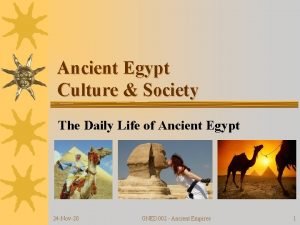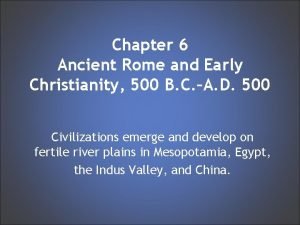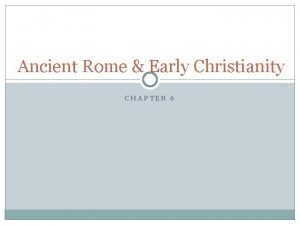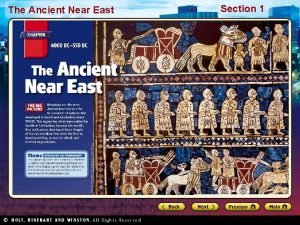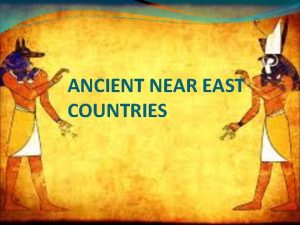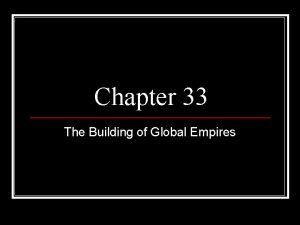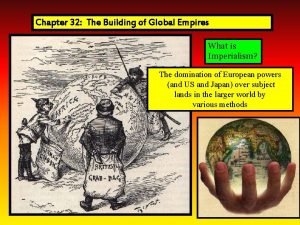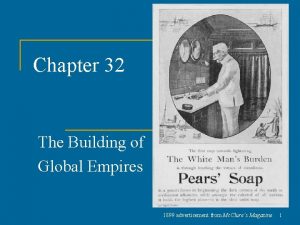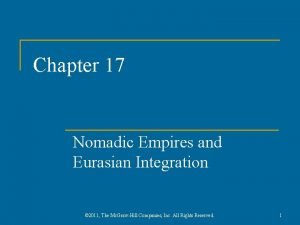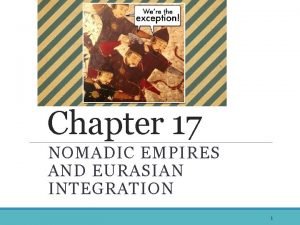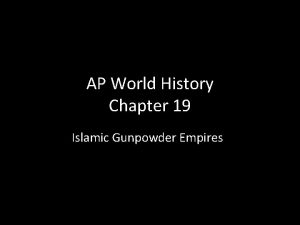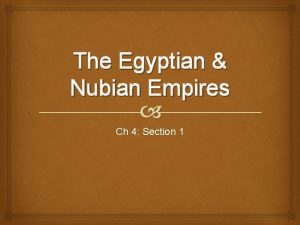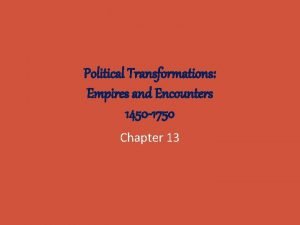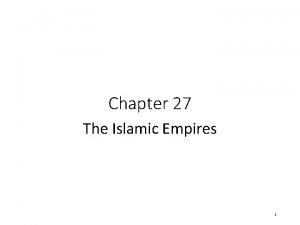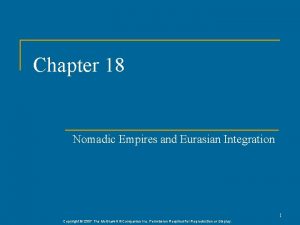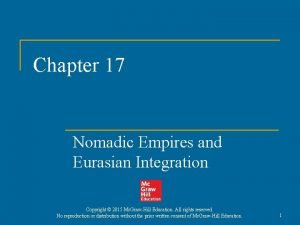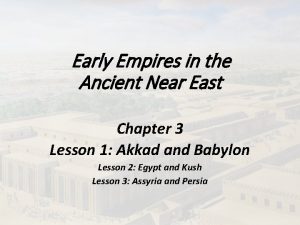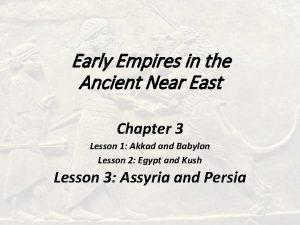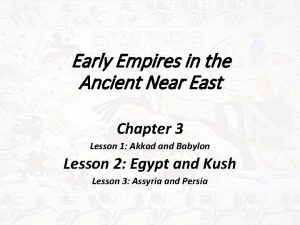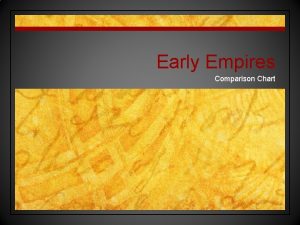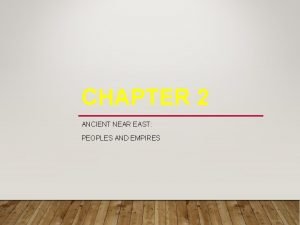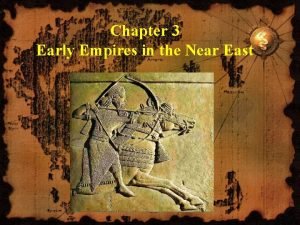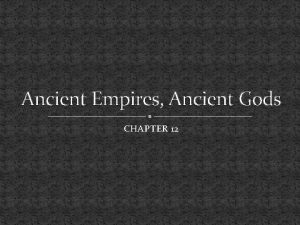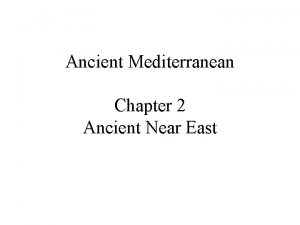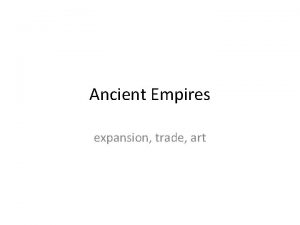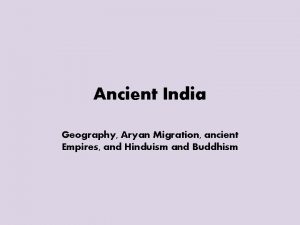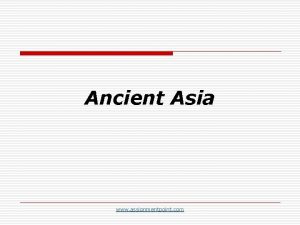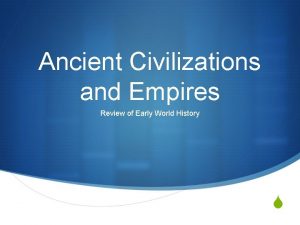Chapter Three Early Empires in the Ancient Near





















- Slides: 21

Chapter Three Early Empires in the Ancient Near East 2300 B. C. -300 B. C.

Lesson One Akkad and Babylon North of the Sumerian city-states were the Akkadians Sargon, the leader of the Akkadians, overran the Sumerian city-dates and set up the first empire in world history Bronze effigy of Sargon Akkad

Lesson One Akkad and Babylon Hammurabi was a king from Babylon He took control of Sumer and Akkad A new empire was formed and Babylon was the capital

Lesson One Akkad and Babylon Hammurabi established Hammurabi’s Code, one of the earliest collection of laws Crimes against a noblemen were severe, but not as severe if a nobleman committed a crime against a peasant

Lesson One Akkad and Babylon “eye for an eye”, punishment should equal the crime The laws were placed on pillars and displayed across the kingdom

Lesson Two Egypt and Kush The Hyksos used chariots to overwhelm the Egyptian soldiers The Hyksos ruled Egypt for about 100 years

Lesson Two Egypt and Kush The Egyptians learned to use bronze and the mastered military skills from the Hyksos The Hyksos were eventually overthrown and replaced by a new Egyptian Dynasty The New Kingdom was established

Lesson Two Egypt and Kush Tutankhamen and Hatshepsut (a woman) both ruled as pharaoh during the New Kingdom

Egypt than had another period of invasions from the Libyans, Nubians, Persians, and the Macedonians after the Conquest of Alexander the Great

Lesson Two Egypt and Kush Cleopatra reestablished Egypt’s independence in the first century B. C. Elizabeth Taylor in the 1960’s film, Cleopatra

Empire of Egypt Pharaohs of the New Kingdom created tombs in the side of hills in order to try and protect them from grave robbers Pharaohs of the Old Kingdom built the massive pyramids which were looted

Lesson Two Egypt and Kush The independent Kingdom of Kush was established around 1, 000 B. C. 750 B. C. The Kush King conquered Egypt 663 The Kushites were overwhelmed by the Assyrians who had iron spears and swords

Lesson Three Assyria and Persia Assyria was located on the upper Tigris River, they used iron weapons to establish an empire around 700 B. C. Kings ruled Assyria with absolute power

Lesson Three Assyria and Persia Staging posts were used to relay messages They were effective conquerors with effective military leaders

Lesson Three Assyria and Persia The Assyrians used terror as an instrument of warfare, often destroying the landscape of the people they conquered They viewed themselves as guardians of Mesopotamian and Babylonian culture

Lesson Three Assyria and Persia After the Assyrian Empire fell Babylonia was rebuilt Babylon became the center of the new empire, it was famous for its hanging gardens, one of the Seven Wonders of the Ancient World

Lesson Three Assyria and Persia The Persians lived in what is today southwestern Iran They were nomadic Cyrus ruled Persia and the rest of the Fertile Crescent from 559 to 530 B. C.

Lesson Three Assyria and Persia Tomb of Cyrus demonstrated wisdom and compassion He was popular among Persians and conquered peoples and showed mercy

Lesson Three Assyria and Persia was divided into 20 provinces called satrapies and ruled by a governor called a satrap The Royal Road of Persia stretched across Asia

Lesson Three Assyria and Persia was ruled by a monarchy with a bureaucratic government The Greeks and Romans modeled their governments after Persia’s

Persia’s religion was Zoroastrian It was a monotheistic religion
 Early empires in the ancient near east
Early empires in the ancient near east Maritime empires vs land empires
Maritime empires vs land empires Ancient empires jar
Ancient empires jar Chapter 6 ancient rome and early christianity
Chapter 6 ancient rome and early christianity Chapter 6 ancient rome and early christianity
Chapter 6 ancient rome and early christianity Rugby style tackling
Rugby style tackling The ancient near east
The ancient near east Ancient near east countries physical education
Ancient near east countries physical education Physical education in primitive era
Physical education in primitive era Chapter 33 the building of global empires
Chapter 33 the building of global empires Chapter 32: the building of global empires
Chapter 32: the building of global empires Chapter 32 the building of global empires
Chapter 32 the building of global empires Chapter 17 nomadic empires and eurasian integration
Chapter 17 nomadic empires and eurasian integration Nomadic empires and eurasian integration
Nomadic empires and eurasian integration Chapter 19 islamic gunpowder empires
Chapter 19 islamic gunpowder empires Chapter 4 section 1 the egyptian and nubian empires
Chapter 4 section 1 the egyptian and nubian empires Chapter 5 political transformations empires and encounters
Chapter 5 political transformations empires and encounters Chapter 27 the islamic empires
Chapter 27 the islamic empires Chapter 27 the islamic empires
Chapter 27 the islamic empires Chapter 18 nomadic empires and eurasian integration
Chapter 18 nomadic empires and eurasian integration Chapter 17 nomadic empires and eurasian integration
Chapter 17 nomadic empires and eurasian integration Chapter 16 people and empires in the americas
Chapter 16 people and empires in the americas


